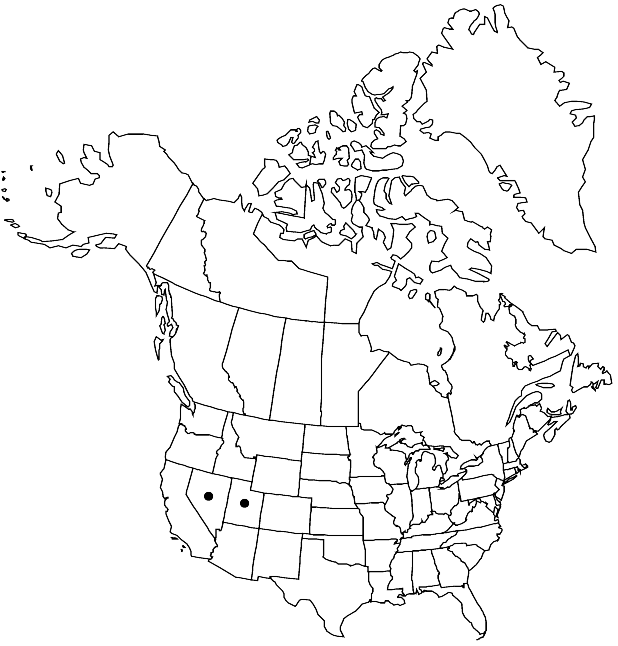familyBrassicaceae
genusPhysaria
speciesPhysaria hitchcockii
subspeciesPhysaria hitchcockii subsp. hitchcockii
Difference between revisions of "Physaria hitchcockii subsp. hitchcockii"
Treatment appears in FNA Volume 7. Treatment on page 643.
FNA>Volume Importer |
imported>Volume Importer |
||
| (6 intermediate revisions by 2 users not shown) | |||
| Line 1: | Line 1: | ||
{{Treatment/ID | {{Treatment/ID | ||
|accepted_name=Physaria hitchcockii subsp. hitchcockii | |accepted_name=Physaria hitchcockii subsp. hitchcockii | ||
| − | |accepted_authority= | + | |accepted_authority= |
|publications= | |publications= | ||
|basionyms= | |basionyms= | ||
| Line 19: | Line 19: | ||
|elevation=2300-3500 m | |elevation=2300-3500 m | ||
|distribution=Nev.;Utah. | |distribution=Nev.;Utah. | ||
| − | |discussion=<p>It is possible that populations of subsp. hitchcockii on the Table Cliff Plateau, Utah, are consubspecific with the nearby subsp. rubicundula. The leaf blades are indistinguishable from the material from Nevada and the plants do not form elongated, elastic caudices.</p><!-- | + | |discussion=<p>It is possible that populations of <i></i>subsp.<i> hitchcockii</i> on the Table Cliff Plateau, Utah, are consubspecific with the nearby <i></i>subsp.<i> rubicundula</i>. The leaf blades are indistinguishable from the material from <i>Nevada</i> and the plants do not form elongated, elastic caudices.</p><!-- |
| − | --><p>Subspecies hitchcockii is found in the Sheep Range and Spring Mountains (Charleston Mountain), Nevada, and on the Table Cliff Plateau, Utah, where it is limited to the white member of the limestone Wasatch (Claron) Formation.</p> | + | --><p>Subspecies hitchcockii is found in the Sheep Range and Spring Mountains (Charleston Mountain), <i>Nevada</i>, and on the Table Cliff Plateau, Utah, where it is limited to the white member of the limestone Wasatch (Claron) Formation.</p> |
|tables= | |tables= | ||
|references= | |references= | ||
| Line 29: | Line 29: | ||
-->{{#Taxon: | -->{{#Taxon: | ||
name=Physaria hitchcockii subsp. hitchcockii | name=Physaria hitchcockii subsp. hitchcockii | ||
| − | + | |authority= | |
| − | |authority= | ||
|rank=subspecies | |rank=subspecies | ||
|parent rank=species | |parent rank=species | ||
| Line 44: | Line 43: | ||
|publication year= | |publication year= | ||
|special status= | |special status= | ||
| − | |source xml=https:// | + | |source xml=https://bitbucket.org/aafc-mbb/fna-data-curation/src/2e0870ddd59836b60bcf96646a41e87ea5a5943a/coarse_grained_fna_xml/V7/V7_1071.xml |
|tribe=Brassicaceae tribe Physarieae | |tribe=Brassicaceae tribe Physarieae | ||
|genus=Physaria | |genus=Physaria | ||
Latest revision as of 23:30, 5 November 2020
Plants forming tufts; caudex not elongated, not elastic. Basal leaves: petiole differentiated from blade (sometimes weakly); blade oblanceolate to obovate. Anthers 1.4–1.8(–2) mm. Fruits 2.6–3.8 mm wide.
Phenology: Flowering Jun–Jul.
Habitat: Gravelly or rocky limestone at or above timberline
Elevation: 2300-3500 m
Discussion
It is possible that populations of subsp. hitchcockii on the Table Cliff Plateau, Utah, are consubspecific with the nearby subsp. rubicundula. The leaf blades are indistinguishable from the material from Nevada and the plants do not form elongated, elastic caudices.
Subspecies hitchcockii is found in the Sheep Range and Spring Mountains (Charleston Mountain), Nevada, and on the Table Cliff Plateau, Utah, where it is limited to the white member of the limestone Wasatch (Claron) Formation.
Selected References
None.
Lower Taxa
None.
